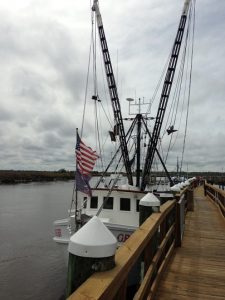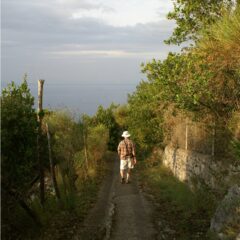In an earlier post, we described and illustrated what the flooded Altamaha was like on our Georgia Conservancy paddle trip. This post will take you down the river and through the marshes to Darien. Remember the water is still up.
We left camp headed for Darien, with most of us leaving our gear up to dry knowing that we’d be shuttled back to camp to pick up cars and belongings. On the water, we passed under the abandoned bridge that had threatened to be a boat magnet on the day before. Once we were safely downstream from the bridge our expert leaders from the Georgia Paddlers Association and the Georgia Conservancy gathered us up for the paddle to Darien.
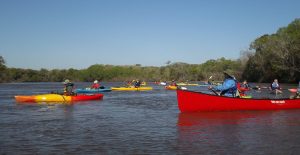
The Altamaha is a big river and on our day on the river it was moving fast so we could easily spread out to an unmanageable degree. To prevent this, the lead boat stopped our forward progress occasionally, however the few stops did little to dampen the enthusiasm of the group

Experienced paddlers and novices both found their stroke and let the mighty river roll them along. Of course, the Altamaha doesn’t actually flow through Darien so one of the concerns of the leaders was making sure that the flotilla didn’t lose any members because they missed the cut off into the creek. The creek, Stud Horse Creek, had a great name and served to provide passage over to Lewis Creek.
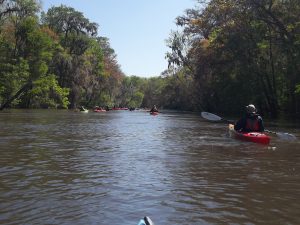
The creek wasn’t that small but if you didn’t know where to turn you would certainly have a problem. We all made it safely down the Altamaha to the creek where one of our safety guides was paddling in place and pointing us in the direction to go. A mile or too into the creek and you began to realize the diversity of the lowland river. We had seen the wide Altamaha with the water out of the banks and now we entered an area of reeds and water grass. A place where we keep a sharp eye for alligators but saw none. You’ll have to wait for the post on the Georgia Conservancy trip to the Okefenoke to hear the alligator stories.

The Altamaha and the river system around it was once a bustling timber industry river route with log rafts built upstream and floated down the river to Darien. Someone decided that the winding river channels weren’t meant for that so, before the Civil War, slave labor was used to build a canal. Our venture through Stud Horse Creek served to put us in position to re-enter the Altamaha just upstream of the Rifle Cut.
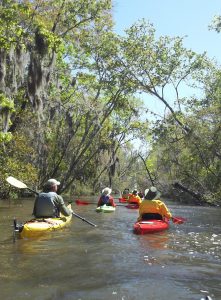
This hand dug canal stretches for a mile across the lowlands and provided us with a short-cut to Darien. Called the “rifle cut” because of its straightness, it is now only a curiosity. The canal doesn’t seem large enough to have been able to handle rafts of logs and indeed the thinking was that erosion would make the canal larger and therefore useable. It didn’t happen. However, because you are in the low lands near the ocean you do need to know about your tides because the water in the rifle cut is greatly influenced by the tide and you might find yourself paddling a little harder than you anticipated if you judge the tides incorrectly. You don’t really want to paddle against the tide for a mile.
You probably know that the trees along the banks of a body of water such a river or stream lend to lean over the channel, but that seemed extreme as we were going through the rifle cut. As you see in the next picture some of these trees seem to have defying gravity for quite a while.
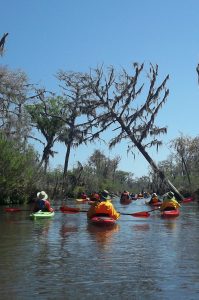
The rifle cut takes you into the Darien River above its confluence with Cathead Creek and on the west side of I-95. It is a bit disconcerting to arrive back at civilization coming under a concrete and steel overpass where thousands of cars pass every day, with almost none of their occupants ever getting the chance to see what we got to see on this trip to Darien. Of course, the trip had to end so we pulled our kayaks up to the boat ramp near Skipper’s Fish Camp. We came to lunch at Skipper’s on this trip and then returned to Skipper’s later in the year when the Bike Ride Across Georgia ended in Darien.
Of course, tied up by the board walk along the river, are all the fishing and shrimping boats that are still in use in Darien. Nearby stand the ruins of the buildings from two hundred years ago when lumber ruled. We’d never been to Darien before, yet we wound up going there twice in one year. Because of that, I had to tell you about getting there and invite you to come paddle along with the great people at the Georgia Conservancy.
